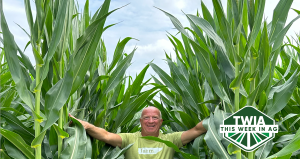This Week In Ag #113
Circa late-1990s. I was sitting at Inness Farm Supply, a plate of BBQ on my lap, listening to the Monsanto rep carry on about the advantages of Roundup Ready Corn. After hearing all the benefits, I asked THE question. “Won’t this accelerate weed resistance?” She looked at me like she wanted to summon security. Then she emphatically assured the group that resistance was not a possibility. I just smiled and replied that nature always finds a way.
It did.
In 2000, resistant horseweed was discovered on the East Coast. Today, 18 weed species across 38 states are resistant to glyphosate, the active ingredient in Roundup. Adding Roundup-resistant corn in rotation with resistant soybeans essentially turned the Midwest into a giant monocropping system.
In 1987, while at Prairie Farmer, I wrote an article on how crop rotation was a critical tool in weed control. Now that tool was lost. By the turn of the century, farmers simply applied one herbicide. Every. Single. Year. Often multiple times per year.
Economically, it made sense – at least in the short term. Despite tech fees for the seed, Roundup was relatively cheap. And it worked. Like nothing we’d ever seen before. There was a belief by many that you couldn’t afford not to incorporate the Roundup system across both crops. It also saved on time and labor.
You might say it made farmers lazy. You didn’t need to scout fields for weeds, much less know how to identify weeds. You simply applied Roundup, and it fried everything.
Until it didn’t.
Misuse is credited by many as the cause of weed resistance. You see, farmers are notorious for cutting corners to save money. And during that era of $2.00/bu corn, many did. They reduced the rates of Roundup to save money. And once again, it worked, until it didn’t.
The reduced rates allowed some weed escapes, which led to non-resistant weed seed. Then it spread. Roundup resistance ushered in the rise of super-weeds, such as Palmer amaranth and water-hemp, which choke out crops and are nearly impossible to economically control, costing growers big money. But weed resistance was just the tip of the iceberg for the world’s most popular herbicide.
Since acquiring Monsanto in 2016, Bayer has paid nearly $11 billion in lawsuits based on carcinogen claims. This has not been a stellar week for Roundup. The documentary “Common Ground” aired on one of the world’s leading streaming platforms, Amazon Prime. The show was unabashed in its criticism of Monsanto and Roundup. And while one could dismiss these claims as political propaganda, the predecessor film “Kiss the Ground” was viewed by over one billion people worldwide.
Then Bayer CEO Bill Anderson warned that the company is “reaching the end of the road” with glyphosate, projecting that absence of court protection against further lawsuits, they could soon stop producing the herbicide.
Despite holding the distinction as the world’s number-one selling weed killer, Bayer reports a net loss of hundreds of millions of dollars on it, due to litigation costs. The company admitted that such costs have exceeded the company’s total AG R&D budget.
Yet for all its flaws, glyphosate remains a cost-effective weed control tool for the majority of row-crop farmers. It’s especially efficient for controlling annual grasses. And ironically, it’s played a pivotal role in the adoption and successful implementation of earth-friendly, soil-saving conservation practices.
Many no-till growers use it as a highly effective burn-down treatment ahead of the planter. It’s also a popular way to terminate cover crops. All of which reinforces the notion that nothing in farming is ever that simple.
Related Posts

Let’s Talk Nutrients for a Minute
by Heather Jennings, PE Generally, in the wastewater industry we talk about 100 mg/L BOD to 5 mg/L Nitrogen to 1 mg/L Phosphorus. The values for nitrogen and phosphorus can be higher or lower than this, but it’s the average number that many wastewater system designs are built around. If you look a little further,

Jason Garcia on Commercial Vegetable Growing with Huma Gro®
With Larry Cooper Vegetable growers in Central Florida are preparing to get their beds ready for planting, so here’s my guide to how Huma Gro® can help growers get their best vegetable crops ever. Bed Preparation It’s become a pretty standard practice for Florida vegetable growers to fumigate their fields, then put down plastic and

This Week in Ag #71
Farmers are not fast forgetters. They have long memories. Past weather events, cultural practices, product usage, and marketing decisions often drive future decisions. With that, I’m guilty as charged. Last season, a straight-line wind caused major greensnap to a new corn hybrid, wrecking my goals. This made me take pause and return to some of the

